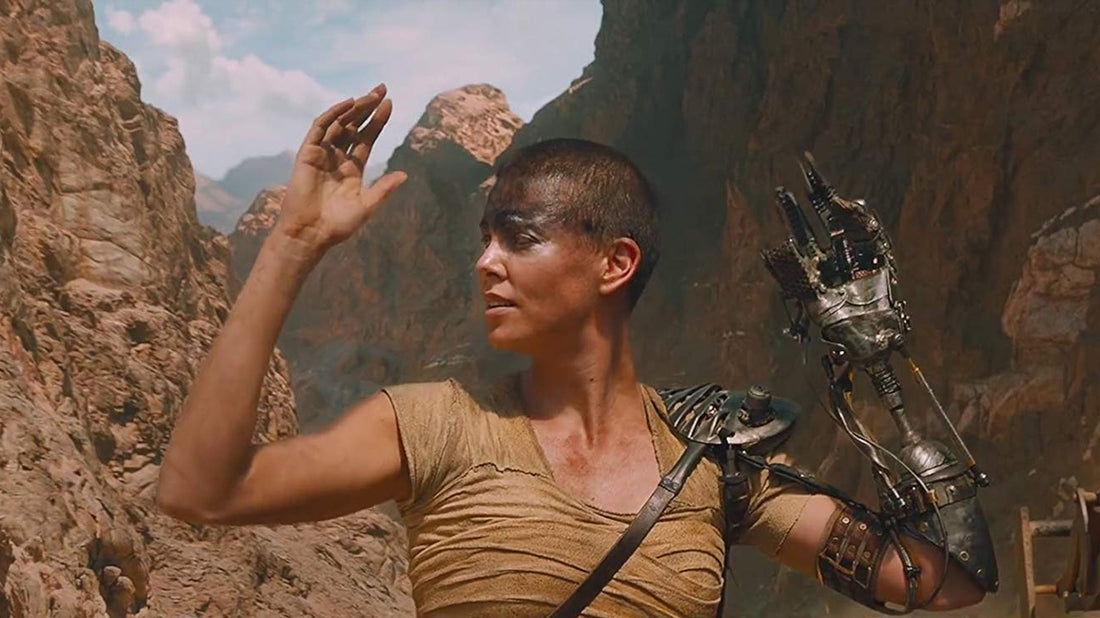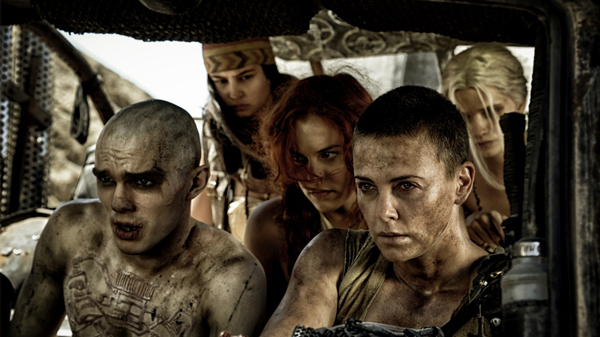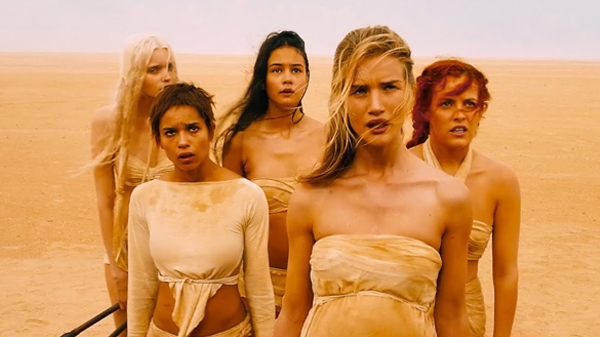It’s a man’s world but there are always women fighting hard enough to make it their own as well. The male gaze often hinders this, but the female body becomes its own form of weapon when used wisely. Rheanna-Marie Hall looks back at the detonation of this physicality for the Five Wives in George Miller’s Mad Max: Fury Road.
The first time the Five Wives appear on screen, we see them as Max does. He rounds the back of the rig, shotgun in hand and unconscious War Boy slung over his shoulder, to find... an oasis? A mirage? After yesterday’s chaotic battle through a sandstorm, it certainly appears a trick of the desert. The women, covered only by thin, gauzy cloth wrapped in strips around their bodies, rub dirt from their thighs and wash their faces with water from a pipe. Max, shotgun raised, stares at the scene before him. A silent stand-off ensues.
Amid the tension, there’s a dull thud. Bolt cutters in hand, a wife finishes the task of cutting away a chastity belt. It hits the sand, and the camera lingers on this image. For a couple of seconds, all you can see is the belt laid at her feet. Mean spikes line the metal. The warlord’s seal adorns it.
Max’s eyebrows briefly pinch together. His stares are intercut with shots of the wives huddled together, and a wary Furiosa. His eyes widen, and the stare grows more intense. The camera cuts to the pool forming underneath the pipe. ‘Water’, he rasps.
Upon first viewing, it’s easy to misread the direction of Max’s stare. In a lesser action film, the gaze of the male – protagonist, antagonist, and bystander alike – is firmly on the woman. Who is she? Whose is she? What can I use her for? What will she get me? In films defined by adrenaline-fuelled heroics and high physical exertion, often arbitrarily packaged as masculine endeavours, a woman’s body is very rarely her own.
More often than not, the female body is code for something else: stakes in a company, wealth, political or personal power, leverage. And so, it becomes the battleground over which male characters fight, a prize both sides will struggle to possess. It’s no coincidence that the end of an action film so often involves a woman rescued, or a woman avenged. The protagonist’s possession of her body signals triumph, and defines him as Hero.
It’s a trope that returns incessantly throughout the genre, spanning decades and countless iterations: from Sarah Connor’s status as the mother of mankind’s saviour in The Terminator, to John Wick’s puppy, the murder of which – as a last gift from, and symbolic stand-in for, the recently deceased wife – sends him on a city-wide killing spree. Taken built an entire franchise off it, producing a plot which relies on the cliché explored in its purest and most exploitative form.
Mad Max: Fury Road begins by setting in motion a post-apocalyptic version of the same story. The desert pursuit is instigated, after all, by the warlord’s discovery of the Wives’ empty chambers, their resistance daubed in white paint across the walls: ‘We are not things’. As the drums sound, and the War Boys rush to their wheels, word travels that Imperator Furiosa ‘took a lot of stuff from Immortan Joe’. ‘What stuff?’ Nux, the War Boy played by Nicholas Hoult, demands to know. ‘Breeders’, comes the reply, ‘His prize breeders! He wants them back, not a hand laid on ’em’.
Throughout the film’s two-hour runtime, the Wives are addressed by names borne of their worth as things: stuff, breeders, stock, treasures, property. Early on, Zoe Kravitz’s character, the wife named Toast, gives Max a piece of sage advice as he grabs her: ‘Don’t damage the goods’.
It’s a wry moment of self-awareness. The Wives’ own understanding of their perceived status, of their bodily value, recasts the film’s relationship with the trope its conflict is rooted in. The establishment of Fury Road as a feminist action film, deviating from the gender norms of its predecessors, starts with the scene in which Max first meets the Wives – when his burning gaze is revealed to be fixed on the sight of fresh water, rather than the bodies it soaks. Because what happens when your male protagonist isn’t interested in possession of the female body? How does the battle play out then?
The obvious solution to this void seems to be in the character of Imperator Furiosa, Charlize Theron’s sharp-shooting war rig driver. At a press conference in Cannes, director George Miller said ‘I needed a warrior. But it couldn’t be a man taking five wives from another man. That’s an entirely different story’.
Miller’s assertion asks the question of what Fury Road would have been without Furiosa. Far less convincing, for sure. Why would the Wives ever trust a man? And in Immortan Joe’s patriarchal society, what kind of man would that even be? He couldn’t come from the ranks of brainwashed Warboys, who themselves exist as ‘an old man’s battle fodder’.
Only a male outsider, someone unfamiliar with the Citadel and a stranger to its culture, could be considered a candidate. However, Max’s initial response to the Wives’ plight, in his attempt to hijack their escape vehicle and leave them in the dust with the might of Immortan Joe’s army bearing down on them, proves that outside help is a slim possibility. In a post-apocalyptic world, personal survival comes first.
It’s challenging to think of action films where women saving women is an essential part of the plot. It’s even harder to name one where the woman in question isn’t doing so because her gender is deemed appropriate for the job by men – a trap Never Go Back, the second film in the Jack Reacher franchise, disappointingly walked straight into when it sidelined its lead female character as perfect for babysitting duty, despite her supposed status as Reacher’s equal.
In early 2019, Netflix released action thriller Close, in which Noomi Rapace stars as a female bodyguard assigned to protect a teenage heiress. Rapace’s extensively skilled and experienced bodyguard is right for the job, we’re told, because the heiress needs a protection officer she can’t sleep with.
Furiosa is much more than a simple substitution of the male protagonist for a female warrior. For one, Furiosa never set out to possess the Wives. Her involvement was sought, as we learn from their teacher Miss Giddy: ‘She didn’t take them; they begged her to go!’. The Wives still retain their autonomy, even in the choice of who saves them from life behind a locked door. Furiosa’s authenticity, as the individual who aids their escape, so too avoids the pitfalls explored with a male protagonist. As revealed later in the film, Furiosa understands being held against her will, after being ‘stolen’ as a child. She is also personally invested in finding the ‘green place’, her family’s home and somewhere she has already attempted to reach ‘many times’.
Furiosa makes the Wives’ bid for freedom possible. What’s crucial is that her existence doesn’t render them passive – this isn’t Furiosa versus Immortan Joe and his army. The battle belongs just as much to the Wives, who fight alongside Furiosa for repossession of their own bodies.
The Wives aren’t physically strong. They have no experience with weaponry or combat, that we know of. But unlike the genre’s more conventional female characters, they’re not automatically rendered powerless. Splendid, the heavily pregnant and proclaimed favourite of Immortan Joe, realises that she can turn the objectification of her body into its own kind of weapon. As she shields Furiosa from gunfire with her swollen stomach, the very pinnacle of the fertility she’s so prized for, the warlord sees no choice but to lower his gun. ‘That’s my child’, he rages. ‘My property’.
Splendid is the first to consciously weaponise her body; in doing so, she not only ensures the others’ escape but also inspires that same action in a myriad of forms. In the final chase, another wife, Cheedo the Fragile, will relinquish her body back to the warlord’s men in order to be lifted onto their vehicle - where she can then help an injured Furiosa. Even the men will follow suit: Max gives his blood for Furiosa, and Nux, with one twist of a wheel, sacrifices his life to save them all.
Fury Road is in fact a film of two battles waged simultaneously. If the first sees Furiosa and the Wives struggle against Immortan Joe for the liberation of their bodies, the second battle encompass a much vaster physical space, when the weight of the struggle is also brought to bear on the Citadel. It represents, for The Vuvalini (Many Mothers), a new beginning, a place to plant their seeds and regrow the Earth. For the patriarchy that owns it, the Citadel is also coded as a female body: just as the Wives were kept in a vault and guarded by chastity belts, so too are the crops of the Citadel and its abundant water source chained and claimed.
Another group of women, enslaved for their bodies, also exists inside its confines. Though they grace the screen for mere moments, the image of at least twenty women, all dead-eyed and clutching ragdolls, being forcibly milked for a liquid Immortan Joe will later trade and profit from, resonates as strongly as the sight of the chastity belts abandoned in the sand.
As befits the fight, the conclusion suggests the establishment of a matriarchy. The women rise together, to the heights of the Citadel. Water flows freely. Somewhere down below, Max merges with the cheering crowd. This isn’t his moment, he understands. This is theirs.
Rheanna-Marie Hall (@rheannamhall) is a freelance writer based in Galloway. She loves actions films and period dramas with equal intensity, and drinks tea with the milk in first.
READ ME is a platform for female-led writing on film commissioned by Girls on Tops. Louisa Maycock (@louisamaycock) is Commissioning Editor and Ella Kemp (@efekemp) is Contributing Editor.





